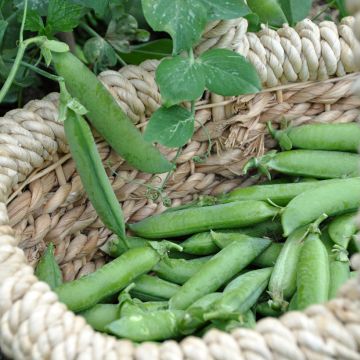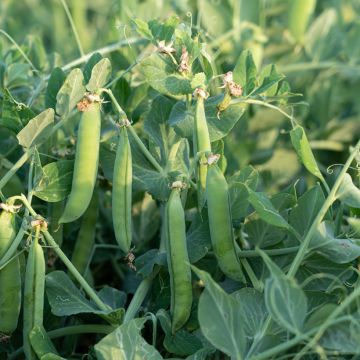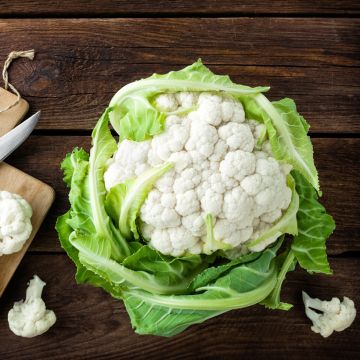

Dwarf pea Orion with round grain
Dwarf pea Orion with round grain
Pisum sativum Orion
Garden pea, Green pea, English pea
This item cannot be shipped to the selected country
Dispatch by letter from €3.90
More information
Schedule delivery date,
and select date in basket
This plant carries a 6 months recovery warranty
More information
We guarantee the quality of our plants for a full growing cycle, and will replace at our expense any plant that fails to recover under normal climatic and planting conditions.
Seed-only orders are dispatched by sealed envelope. The delivery charge for seed-only orders is €3.90.
Description
The 'Orion' Pea is a very productive variety of dwarf shelling peas (smooth seeds), which produces pods filled with approximately 10 dark green round peas. They have excellent taste quality. Harvest from May to August. Very resistant variety to the yellow bean mosaic virus. Good for freezing.
The pea is an annual vegetable plant that has its ancient origin in the Near East. It is one of the oldest vegetables cultivated in Europe and Asia and has long been consumed dried and crushed before cooking. Its fresh consumption is rather recent and its nutritional and taste qualities make it an excellent spring vegetable.
There are many varieties, dwarf or climbing (pole) peas producing pods containing round, wrinkled or smooth seeds. Either the pod must be shelled, or it can be consumed whole.
For "shelling peas", the pod is not good for consumption because it is parchment-like, like green beans; therefore, it must be shelled. It is in this category that there is the widest choice of varieties and sizes. Among "shelling peas", there are: wrinkled peas, sweeter and more heat-tolerant, and smooth or round peas, more suitable for early cultivation, as they are hardier and less sensitive to moisture levels. In the vegetable garden, we start with smooth peas, and we sow wrinkled seeds later.
The "mangetout" or "sugar snap" pea, whose pod is not parchment-like, is edible in its entirety by harvesting it before the complete formation of the seeds. If harvested later, it can be shelled to be consumed like fresh peas.
The pea likes mild and humid climates. It dislikes extremes: heat, frost, drought and excess water.
Harvest
Depending on the earliness of the varieties, peas are harvested between two and a half to four months after sowing.
Pick shelling peas when the pods are well filled (about twice a week), but still green.
Storage
Fresh peas can be stored, unshelled, for 48 hours in the vegetable drawer of the refrigerator
The flavour of round peas is finer, and their beautiful presentation is better suited for canning or freezing.
Wrinkled varieties are sweeter than round peas, and the seeds remain tender for longer in the pods if the harvest is a little late.
The gardener's little trick
Peas, like all plants in the Fabaceae family, enrich the soil with nitrogen. They are part of a rotation that takes place over 4 years. Peas are plants that are not very demanding in nutrients. Peas also associate very well with carrots, celery, cabbage, turnips, potatoes, and radishes because they protect each other. Avoid the presence of alliums or fennel as their growth inhibits each other.
Report an error about the product description
Harvest
Plant habit
Foliage
Botanical data
Pisum
sativum
Orion
Fabaceae
Garden pea, Green pea, English pea
Cultivar or hybrid
Annual
Other Pea seeds
Planting and care
Sowing
Before sowing, you can soak the seeds for 24 hours in a little water to stimulate germination.
For this variety of wrinkled peas, you can sow them from mid-March to the end of May, when the temperature is 7 to 10°C at night, and 18 to 23°C during the day.
Using a hoe, open furrows 2 or 3cm (1in) deep, spaced 40cm (16in) apart for this variety of dwarf peas. Space the seeds 2cm (1in) apart, cover them, firm the soil with the back of the rake, and water lightly. Do not thin out.
Watering
A few days after germination, hoe along the rows. Water with a watering can fitted with a rose to avoid compacting the soil.
When the plants are well established, mulch the soil after a rainy period.
Do not let the soil dry out, as peas appreciate moisture. They need regular moisture from sowing to flowering, and then to pod formation. In cases of water stress, production is affected. The flowers drop and the pods do not ripen. Similarly, in the case of excess water, the flowers abort. Maintaining moisture in this way also helps to limit thrips infestations.
Maintenance
Three to four weeks after seed germination, carefully hoe and bury the base of the stems to a depth of about 10cm (4in) to promote better rooting. Then set up the supports, branches (willow, hazel, privet...), netting or trellis, even for the dwarf varieties so that they do not collapse. Depending on the varieties, make them more or less tall, climbing peas can reach up to 2m (7ft).
Pinch the stems of dwarf peas above the fifth or sixth group of flowers to speed up production.
Seedlings
Care
Intended location
This item has not been reviewed yet - be the first to leave a review about it.
Vegetable seeds
Haven't found what you were looking for?
Hardiness is the lowest winter temperature a plant can endure without suffering serious damage or even dying. However, hardiness is affected by location (a sheltered area, such as a patio), protection (winter cover) and soil type (hardiness is improved by well-drained soil).

Photo Sharing Terms & Conditions
In order to encourage gardeners to interact and share their experiences, Promesse de fleurs offers various media enabling content to be uploaded onto its Site - in particular via the ‘Photo sharing’ module.
The User agrees to refrain from:
- Posting any content that is illegal, prejudicial, insulting, racist, inciteful to hatred, revisionist, contrary to public decency, that infringes on privacy or on the privacy rights of third parties, in particular the publicity rights of persons and goods, intellectual property rights, or the right to privacy.
- Submitting content on behalf of a third party;
- Impersonate the identity of a third party and/or publish any personal information about a third party;
In general, the User undertakes to refrain from any unethical behaviour.
All Content (in particular text, comments, files, images, photos, videos, creative works, etc.), which may be subject to property or intellectual property rights, image or other private rights, shall remain the property of the User, subject to the limited rights granted by the terms of the licence granted by Promesse de fleurs as stated below. Users are at liberty to publish or not to publish such Content on the Site, notably via the ‘Photo Sharing’ facility, and accept that this Content shall be made public and freely accessible, notably on the Internet.
Users further acknowledge, undertake to have ,and guarantee that they hold all necessary rights and permissions to publish such material on the Site, in particular with regard to the legislation in force pertaining to any privacy, property, intellectual property, image, or contractual rights, or rights of any other nature. By publishing such Content on the Site, Users acknowledge accepting full liability as publishers of the Content within the meaning of the law, and grant Promesse de fleurs, free of charge, an inclusive, worldwide licence for the said Content for the entire duration of its publication, including all reproduction, representation, up/downloading, displaying, performing, transmission, and storage rights.
Users also grant permission for their name to be linked to the Content and accept that this link may not always be made available.
By engaging in posting material, Users consent to their Content becoming automatically accessible on the Internet, in particular on other sites and/or blogs and/or web pages of the Promesse de fleurs site, including in particular social pages and the Promesse de fleurs catalogue.
Users may secure the removal of entrusted content free of charge by issuing a simple request via our contact form.
The flowering period indicated on our website applies to countries and regions located in USDA zone 8 (France, the United Kingdom, Ireland, the Netherlands, etc.)
It will vary according to where you live:
- In zones 9 to 10 (Italy, Spain, Greece, etc.), flowering will occur about 2 to 4 weeks earlier.
- In zones 6 to 7 (Germany, Poland, Slovenia, and lower mountainous regions), flowering will be delayed by 2 to 3 weeks.
- In zone 5 (Central Europe, Scandinavia), blooming will be delayed by 3 to 5 weeks.
In temperate climates, pruning of spring-flowering shrubs (forsythia, spireas, etc.) should be done just after flowering.
Pruning of summer-flowering shrubs (Indian Lilac, Perovskia, etc.) can be done in winter or spring.
In cold regions as well as with frost-sensitive plants, avoid pruning too early when severe frosts may still occur.
The planting period indicated on our website applies to countries and regions located in USDA zone 8 (France, United Kingdom, Ireland, Netherlands).
It will vary according to where you live:
- In Mediterranean zones (Marseille, Madrid, Milan, etc.), autumn and winter are the best planting periods.
- In continental zones (Strasbourg, Munich, Vienna, etc.), delay planting by 2 to 3 weeks in spring and bring it forward by 2 to 4 weeks in autumn.
- In mountainous regions (the Alps, Pyrenees, Carpathians, etc.), it is best to plant in late spring (May-June) or late summer (August-September).
The harvesting period indicated on our website applies to countries and regions in USDA zone 8 (France, England, Ireland, the Netherlands).
In colder areas (Scandinavia, Poland, Austria...) fruit and vegetable harvests are likely to be delayed by 3-4 weeks.
In warmer areas (Italy, Spain, Greece, etc.), harvesting will probably take place earlier, depending on weather conditions.
The sowing periods indicated on our website apply to countries and regions within USDA Zone 8 (France, UK, Ireland, Netherlands).
In colder areas (Scandinavia, Poland, Austria...), delay any outdoor sowing by 3-4 weeks, or sow under glass.
In warmer climes (Italy, Spain, Greece, etc.), bring outdoor sowing forward by a few weeks.
























































